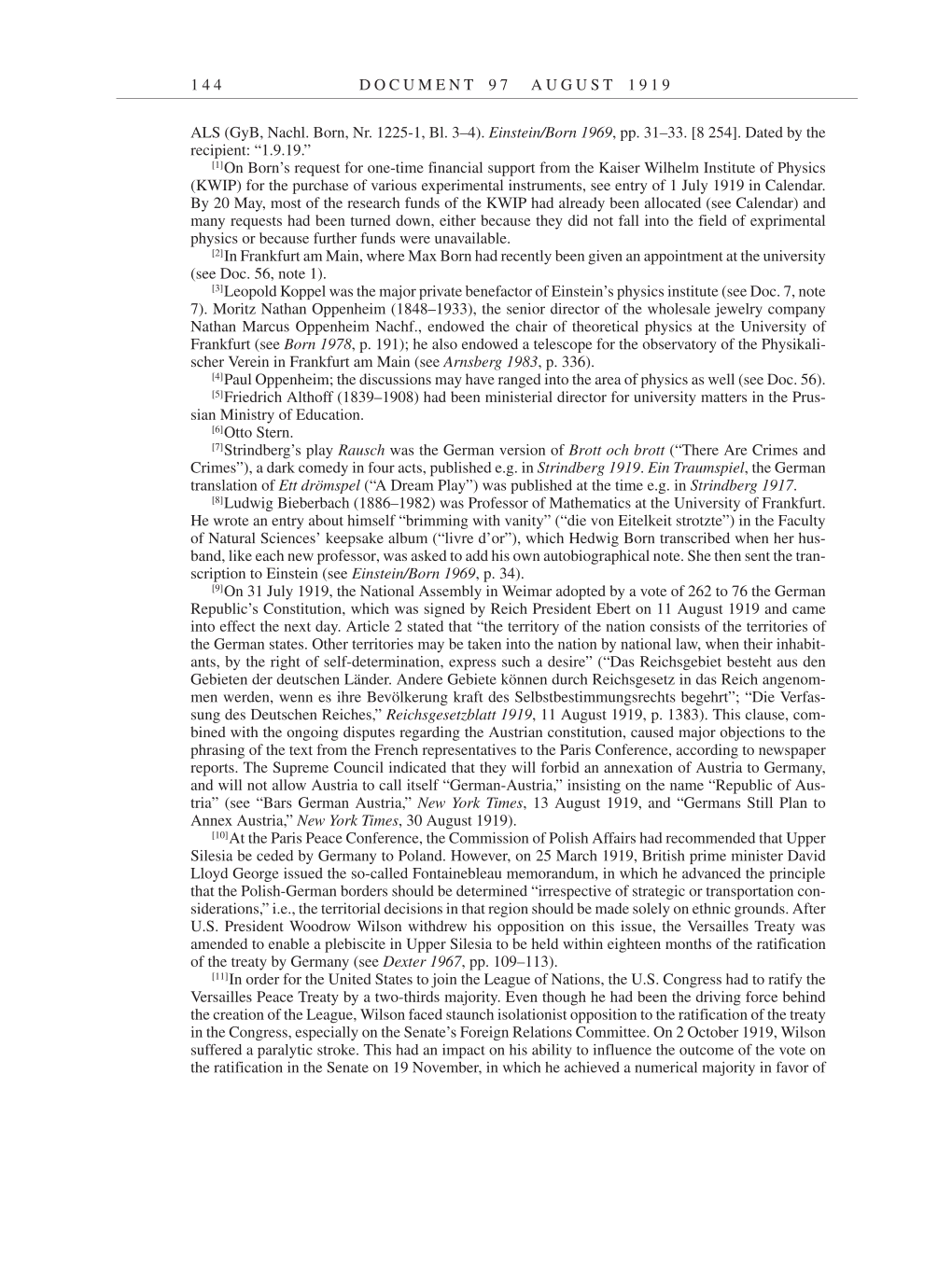1 4 4 D O C U M E N T 9 7 A U G U S T 1 9 1 9
ALS (GyB, Nachl. Born, Nr. 1225-1, Bl. 3–4). Einstein/Born 1969, pp. 31–33. [8 254]. Dated by the
recipient: “1.9.19.”
[1]On Born’s request for one-time financial support from the Kaiser Wilhelm Institute of Physics
(KWIP) for the purchase of various experimental instruments, see entry of 1 July 1919 in Calendar.
By 20 May, most of the research funds of the KWIP had already been allocated (see Calendar) and
many requests had been turned down, either because they did not fall into the field of exprimental
physics or because further funds were unavailable.
[2]In Frankfurt am Main, where Max Born had recently been given an appointment at the university
(see Doc. 56, note 1).
[3]Leopold Koppel was the major private benefactor of Einstein’s physics institute (see Doc. 7, note
7). Moritz Nathan Oppenheim (1848–1933), the senior director of the wholesale jewelry company
Nathan Marcus Oppenheim Nachf., endowed the chair of theoretical physics at the University of
Frankfurt (see Born 1978, p. 191); he also endowed a telescope for the observatory of the Physikali-
scher Verein in Frankfurt am Main (see Arnsberg 1983, p. 336).
[4]Paul Oppenheim; the discussions may have ranged into the area of physics as well (see Doc. 56).
[5]Friedrich Althoff (1839–1908) had been ministerial director for university matters in the Prus-
sian Ministry of Education.
[6]Otto Stern.
[7]Strindberg’s play Rausch was the German version of Brott och brott (“There Are Crimes and
Crimes”), a dark comedy in four acts, published e.g. in Strindberg 1919. Ein Traumspiel, the German
translation of Ett drömspel (“A Dream Play”) was published at the time e.g. in Strindberg 1917.
[8]Ludwig Bieberbach (1886–1982) was Professor of Mathematics at the University of Frankfurt.
He wrote an entry about himself “brimming with vanity” (“die von Eitelkeit strotzte”) in the Faculty
of Natural Sciences’ keepsake album (“livre d’or”), which Hedwig Born transcribed when her hus-
band, like each new professor, was asked to add his own autobiographical note. She then sent the tran-
scription to Einstein (see Einstein/Born 1969, p. 34).
[9]On 31 July 1919, the National Assembly in Weimar adopted by a vote of 262 to 76 the German
Republic’s Constitution, which was signed by Reich President Ebert on 11 August 1919 and came
into effect the next day. Article 2 stated that “the territory of the nation consists of the territories of
the German states. Other territories may be taken into the nation by national law, when their inhabit-
ants, by the right of self-determination, express such a desire” (“Das Reichsgebiet besteht aus den
Gebieten der deutschen Länder. Andere Gebiete können durch Reichsgesetz in das Reich angenom-
men werden, wenn es ihre Bevölkerung kraft des Selbstbestimmungsrechts begehrt”; “Die Verfas-
sung des Deutschen Reiches,” Reichsgesetzblatt 1919, 11 August 1919, p. 1383). This clause, com-
bined with the ongoing disputes regarding the Austrian constitution, caused major objections to the
phrasing of the text from the French representatives to the Paris Conference, according to newspaper
reports. The Supreme Council indicated that they will forbid an annexation of Austria to Germany,
and will not allow Austria to call itself “German-Austria,” insisting on the name “Republic of Aus-
tria” (see “Bars German Austria,” New York Times, 13 August 1919, and “Germans Still Plan to
Annex Austria,” New York Times, 30 August 1919).
[10]At the Paris Peace Conference, the Commission of Polish Affairs had recommended that Upper
Silesia be ceded by Germany to Poland. However, on 25 March 1919, British prime minister David
Lloyd George issued the so-called Fontainebleau memorandum, in which he advanced the principle
that the Polish-German borders should be determined “irrespective of strategic or transportation con-
siderations,” i.e., the territorial decisions in that region should be made solely on ethnic grounds. After
U.S. President Woodrow Wilson withdrew his opposition on this issue, the Versailles Treaty was
amended to enable a plebiscite in Upper Silesia to be held within eighteen months of the ratification
of the treaty by Germany (see Dexter 1967, pp. 109–113).
[11]In order for the United States to join the League of Nations, the U.S. Congress had to ratify the
Versailles Peace Treaty by a two-thirds majority. Even though he had been the driving force behind
the creation of the League, Wilson faced staunch isolationist opposition to the ratification of the treaty
in the Congress, especially on the Senate’s Foreign Relations Committee. On 2 October 1919, Wilson
suffered a paralytic stroke. This had an impact on his ability to influence the outcome of the vote on
the ratification in the Senate on 19 November, in which he achieved a numerical majority in favor of
